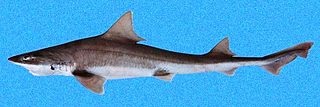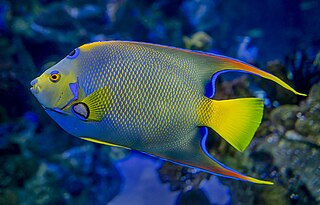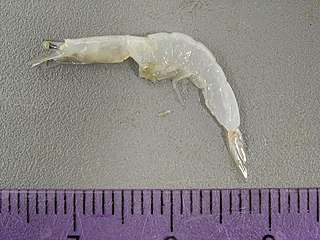
Bycatch, in the fishing industry, is a fish or other marine species that is caught unintentionally while fishing for specific species or sizes of wildlife. Bycatch is either the wrong species, the wrong sex, or is undersized or juveniles of the target species. The term "bycatch" is also sometimes used for untargeted catch in other forms of animal harvesting or collecting. Non-marine species that are caught but regarded as generally "undesirable" are referred to as rough fish or coarse fish.

The smalleye hammerhead, also called the golden hammerhead or curry shark, is a small species of hammerhead shark in the family Sphyrnidae. This species was historically common in the shallow coastal waters of the western Atlantic Ocean, from Venezuela to Uruguay. It favors muddy habitats with poor visibility, reflected by its relatively small eyes. Adult males and juveniles are schooling and generally found apart from the solitary adult females. Typically reaching 1.2–1.3 m (3.9–4.3 ft) in length, this shark has a unique, bright golden color on its head, sides, and fins, which was only scientifically documented in the 1980s. As in all hammerheads, its head is flattened and laterally expanded into a hammer-shaped structure called the cephalofoil, which in this species is wide and long with an arched front margin bearing central and lateral indentations.

The brown smooth-hound is a houndshark of the family Triakidae. The reproduction of this shark is viviparous. The brown smooth-hound reaches a maximum reported size of 95.0 cm and a minimum of 27.6cm amongst males while females can range from 25.7 cm to 100 cm although males reach their asymptotic length sooner than females. The average size of this species is between 50 and 70 cm and is between 19 and 21 cm at birth. Females at maternity are around 67.6 cm long whereas the average length at maturity is 63.6 cm for males and 65.6 cm for females. This species is a ground shark and has a heterocercal caudal fin bearing an elongate upper lobe, triangular and broad dorsal fins, broad pectoral fins, an inferior mouth, and large eyes, and displays a reddish or bronze coloration from above and a silverish coloration on the underside. The shark is additionally slender, long-snouted, and sharp-toothed. The teeth of the brown smooth-hound often bear a narrow primary cusp and one or two accessory cusplets.

The queen angelfish, also known as the blue angelfish, golden angelfish, or yellow angelfish, is a species of marine angelfish found in the western Atlantic Ocean. It is a benthic warm-water species that lives in coral reefs. It is recognized by its blue and yellow coloration and a distinctive spot or "crown" on its forehead. This crown distinguishes it from the closely related and similar-looking Bermuda blue angelfish, with which it overlaps in range and can interbreed.

Harold Carl Otto Loesch was a marine biologist and oceanographer who is credited with being the first to examine the Mobile Bay jubilee in an academic journal(Ecology).paper

The Bahia mangroves is a tropical ecoregion of the mangroves biome, and the South American Atlantic Forest biome, located in Northeastern Brazil. Its conservation status is considered to be critical/endangered due to global climate change and other factors.

Xiphopenaeus kroyeri, commonly called the Atlantic seabob, is a commercially important prawn. It is up to 140 mm (5.5 in) long and is the most intensely fished prawn species in the Guianas and along much of the Gulf Coast of the United States.

Lysmata is a genus of shrimp in the infraorder Caridea, the caridean shrimp. The genus belongs to the family Lysmatidae. Lysmata are popular ornamental shrimp in the marine aquarium trade for their bright color patterns, interesting behaviors, and ability to control certain aquarium pests such as sea anemones of the genus Aiptasia. They are known to command high prices on the pet market.

Centropomus parallelus is a species of fish in the family Centropomidae, the snooks and robalos. It is known by several common names, including fat snook, smallscale fat snook, little snook, and chucumite. It is native to the western Atlantic Ocean and Gulf of Mexico, its distribution extending from southern Florida in the United States to southern Brazil near Florianópolis.

Notoscopelus elongatus is a species of lanternfish in the family Myctophidae. It is endemic to the Mediterranean Sea where it is found in deep water habitats, rising to near the surface to feed at night and descending to great depths by day. It is a common species with no particular threats, and the International Union for Conservation of Nature has listed its conservation status as being of least concern.
The hidden angelshark(Squatina occulta) is a species of angelshark that was named by Carolus Maria Vooren and Kleber Grübel da Silva in 1991. It inhabits the Atlantic coastline of South America from southern Brazil to Argentina. Hidden angel sharks grow up to 124 cm in length and are ovoviviparous, meaning the embryos develop inside eggs that remain inside the mother's body until they are ready to hatch.
Hippolyte californiensis, the California green shrimp, is a species of shrimp in the family Hippolytidae. It is native to the eastern Pacific Ocean. It was first described in 1895 by the zoologist S.J. Holmes from Bodega Bay, California. Of the 32 or so species in the genus Hippolyte, it is most closely related to H. obliquimanus and H. williamsi.
Palaemon ritteri is a species of shrimp of the family Palaemonidae. It lives in both the Atlantic and Pacific Oceans surrounding South America.
Palaemon paivai is a species of shrimp of the family Palaemonidae. It is endemic to the state of Ceará, Brazil.

Periclimenes, commonly known as glass shrimp or cleaner shrimp, is a commensal and often symbiotic genus of semi-transparent shrimp within the family Palaemonidae. Species of this large genus feature a wide variety of coloration and patterns, widespread distribution throughout much of the world's tropical oceans, and are often sought out for aquarium trade.

Callichirus major sensu lato is a monophyletic species complex of ghost shrimp in the infraorder Axiidea, found in flat sandy beaches across the Pan-American coastline.

Hepatus pudibundus, the flecked box crab, is a crab from the class Malacostraca. They are found in the Atlantic Ocean with Brazil having a dense population of H. pudibundus, as they are one of the most commonly seen crabs in the country. Many of the studies done on H. pudibubus have occurred in the Ubatuba region of Brazil, where there is a rapid expansion of tourism that is affecting marine ecosystems.

Tubastraea tagusensis is a hard coral species in the family Dendrophylliidae. The species is azooxanthellate, thus does not need sunlight for development, and does not form reefs. It is native to the Galapagos Islands but has become invasive along the Atlantic coast of South America.

Acetes americanus is a small shrimp species in the family Sergestidae found in the western Atlantic Ocean between Brazil and the United States.

The Guianan marine ecoregion stretches along the middle of the northeast coast of South America, touching Venezuela, Guyana, Suriname and French Guiana. It extends about 200 miles offshore, with the warm Guianan Current moving east-to-west through the region. This current brings in fresh, turbid waters from the mouth of the Amazon River to the east. As the current exits the ecoregion to the west it contributes an estimated 70% of the waters of the Caribbean Sea. A very large oil field has been recently discovered in the Guyana-Suriname Basin of the ecoregion. The Guianan is one of two ecoregions in the North Brazil Shelf province, a Large marine ecosystem (LME). The Guianan is thus part of the larger Tropical Atlantic realm.
















